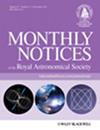Effects of nucleon-nucleon short-range correlation and symmetry energy on the evolution of newly born magnetars
IF 4.8
3区 物理与天体物理
Q1 ASTRONOMY & ASTROPHYSICS
引用次数: 0
Abstract
Millisecond magnetars are widely suggested as the central engines powering hydrogen-poor superluminous supernovae (SLSNe). These magnetars primarily lose huge rotational energy through gravitational wave radiation (GWR) and magnetic dipole radiation (MDR), with MDR serving as an energy source for SLSNe. We study the evolution of the magnetar spin, magnetic inclination angle, and the resulting thermal radiative luminosity of the SLSNe, where the impacts of the nucleon-nucleon short-range correlation, the mass and initial spin of the magnetar, and the density-dependent symmetry energy of the dense nuclear matter on the evolution are discussed. The relativistic mean-field theory is employed to calculate the nuclear matter properties, and we particularly concentrate on the time- and space-dependent bulk viscosity which is crucial for the magnetic inclination angle evolution. It is found that the nucleon-nucleon short-range correlation weakens the damping of bulk viscosity of dense matter and therefore inhibits the growth of magnetic inclination angle, and it reduces the MDR (GWR) peak luminosity of a canonical magnetar by several times while it raises the peak thermal radiation luminosity of SLSNe by several times. For magnetars with nonrotating mass obviously lower than the $1.4 \, \rm M_\odot$ with slow initial rotation, the magnetic inclination angle is more likely to evolve towards 0 degrees quickly, and these magnetars are not suitable as the central engine for SLSNe. Within the ‘family’ of FSUGarnet interaction, a stiffer symmetry energy gives a lower threshold of direct Urca process and hence gives a much larger bulk viscosity coefficient, and thus it promotes the growth of the magnetic inclination angle and the GWR for canonical stars but reduces the peak brightness of SLSNe significantly.核子-核子短程相关性和对称能对新生磁星演化的影响
人们普遍认为毫秒磁星是为贫氢超新星(SLSNe)提供动力的中心引擎。这些磁星主要通过引力波辐射(GWR)和磁偶极子辐射(MDR)损失巨大的旋转能量,其中MDR是SLSNe的能量来源。我们研究了磁星自旋、磁倾角以及由此产生的SLSNe热辐射光度的演化,讨论了核子-核子短程相关性、磁星质量和初始自旋以及密度相关的致密核物质对称能对演化的影响。我们采用相对论均场理论来计算核物质的特性,并特别关注与时间和空间相关的体粘度,这对磁倾角的演化至关重要。研究发现,核子-核子短程相关会减弱致密物质体粘度的阻尼,从而抑制磁倾角的增长,并使典型磁星的 MDR(GWR)峰值光度降低数倍,而使 SLSNe 的热辐射峰值光度提高数倍。对于非旋转质量明显低于1.4美元(\rm M_\odot$)、初始旋转缓慢的磁星来说,磁倾角更有可能迅速向0度演化,而这些磁星并不适合作为SLSNe的中心引擎。在FSU-Garnet相互作用的 "家族 "中,较硬的对称能使直接Urca过程的阈值更低,从而使体积粘滞系数更大,因此它促进了磁倾角和典型恒星GWR的增长,但却大大降低了SLSNe的峰值亮度。
本文章由计算机程序翻译,如有差异,请以英文原文为准。
求助全文
约1分钟内获得全文
求助全文
来源期刊

Monthly Notices of the Royal Astronomical Society
ASTRONOMY & ASTROPHYSICS-
CiteScore
9.10
自引率
37.50%
发文量
3198
审稿时长
3 months
期刊介绍:
Monthly Notices of the Royal Astronomical Society is one of the world''s leading primary research journals in astronomy and astrophysics, as well as one of the longest established. It publishes the results of original research in positional and dynamical astronomy, astrophysics, radio astronomy, cosmology, space research and the design of astronomical instruments.
 求助内容:
求助内容: 应助结果提醒方式:
应助结果提醒方式:


